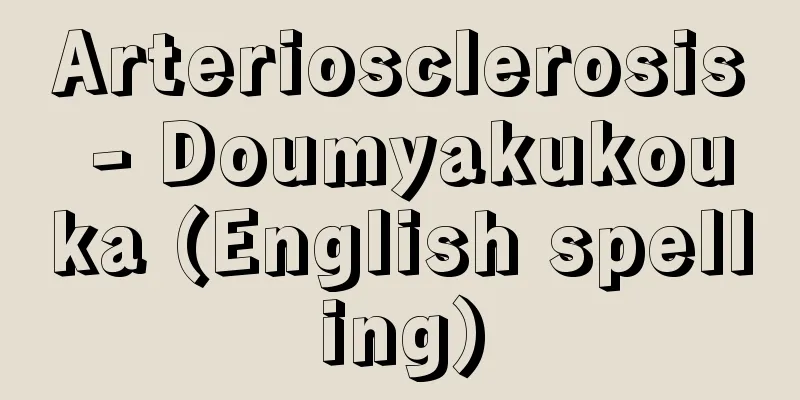Arteriosclerosis - Doumyakukouka (English spelling)

What is the disease?Arteries play an important role in carrying oxygen and nutrients to every corner of the body. As we age, these arteries lose their elasticity and become hard, and various substances are deposited in the arteries, narrowing the blood vessels and impeding blood flow. This condition is called arteriosclerosis. Arteriosclerosis is: What is the cause? Atherosclerosis, which is the most clinically important, is a hardening that occurs in relatively large arteries such as the aorta, cerebral arteries, and coronary arteries, and is caused by the buildup of fats such as cholesterol in the inner lining of the arteries. Bad cholesterol (LDL cholesterol), which causes atheroma, is found in large amounts in animal fats. On the other hand, good cholesterol (HDL cholesterol) has the effect of suppressing arteriosclerosis. Neutral fats are also said to promote arteriosclerosis. Neutral fat levels rise when you consume sugar or alcohol. Arteriosclerosis is a type of arteriosclerosis in which small arteries in the brain and kidneys harden and blood flow stagnates. It is caused by prolonged high blood pressure. The causes of or progression of arteriosclerosis are called "risk factors." Furthermore, these risk factors are interrelated, and as the number of factors increases, the risk of arteriosclerosis increases exponentially. Reducing these risk factors is extremely important for both treatment and prevention. Diseases that are prone to arteriosclerosisAtherosclerosis can occur in arteries throughout the body, but we will briefly explain the areas and diseases in which it is particularly likely to occur. For more information, see the section on each disease. Stroke is When blood flow is impaired due to cerebral arteriosclerosis, it can cause dizziness, headaches, tinnitus, memory loss, short tempers, and irritability. Symptoms such as dementia are also more likely to appear. If blood flow is completely cut off, it will cause cerebral infarction, and if fragile blood vessels rupture and bleed, it will cause cerebral hemorrhage. When arteriosclerosis occurs in the coronary arteries that carry oxygen and nutrients to the heart, the blood flow to the heart decreases, causing chest pain and shortness of breath during exercise. This is called angina pectoris. If the plaque ruptures and the coronary artery becomes completely blocked by a blood clot, this is called myocardial infarction. Aortic aneurysm is a swelling of the aorta in the chest or abdomen caused by arteriosclerosis. The swelling gradually grows and eventually bursts, causing massive bleeding and death. If high blood pressure continues for a long period of time, the small arteries in the kidneys will harden, causing kidney function to decline. You will wake up several times at night to urinate, and you will produce a lot of pale urine. High blood pressure can suddenly worsen. When arteriosclerosis occurs in the arteries of the lower limbs and blood flow is restricted, the legs may become numb, feel cold, or become painful when walking. Testing and diagnosis Risk factors are searched for. First, blood pressure is measured to check for high blood pressure. Blood tests are used to measure the amount of cholesterol, neutral fat, sugar, and uric acid in the blood to check for dyslipidemia, diabetes, hyperuricemia, etc. Furthermore, tests are performed to identify the area where arteriosclerosis is occurring. Fundus examination is performed to check for changes in the retinal arteries. If arteriosclerosis is found in the retina, there is a possibility that the same degree of arteriosclerosis is occurring in the arteries of the brain. Treatment methodsFirst, removing risk factors by changing lifestyle habits such as diet and exercise is important for treating and preventing diseases caused by arteriosclerosis. ① Exercise Obesity accelerates the progression of arteriosclerosis, so it is important to be careful not to overeat and to be physically active on a daily basis. Walking or light jogging every day reduces neutral fats and increases good cholesterol, which has preventive and therapeutic effects against arteriosclerosis. Exercise also helps prevent high blood pressure and diabetes. ②Dietary therapy Be careful not to consume too much animal fats such as meat, eggs, and butter, which can hasten the onset and progression of arteriosclerosis. Use vegetable fats such as margarine and salad oil, and increase your protein intake from fish and soybeans. Blue fish such as sardines, mackerel, and pacific saury have the effect of lowering cholesterol and neutral fat in the blood and preventing blood from clotting. Dietary fiber also prevents cholesterol absorption in the small intestine and helps to excrete it. It is found in large amounts in vegetables such as burdock, seaweed, mushrooms, and konjac, and helps prevent obesity. Too much salt can lead to high blood pressure, and too much sugar can lead to diabetes, so you need to be careful. Drink alcohol in moderation, and it's best to quit smoking. 3) Drug treatment The most important drug treatment for arteriosclerosis is drugs that lower cholesterol. Recently, drugs that reliably lower cholesterol, such as HMGCoA reductase inhibitors, have been widely used. Antiplatelet drugs are also used to prevent blood vessels from clogging. Drug treatment for high blood pressure, diabetes, and hyperuricemia is also important. ④ Surgical treatment When the lumen of blood vessels has been narrowed by plaque, bypass surgery or catheter-based vasodilation therapy may be used to restore blood flow. Ikeda Uichi "> Figure 26 Mechanism of atherosclerosis Source: Houken “Sixth Edition Family Medicine Encyclopedia” Information about the Sixth Edition Family Medicine Encyclopedia |
どんな病気か体のすみずみまで酸素や栄養素を運ぶ重要な役割を果たしているのが動脈です。この動脈が年齢とともに老化し、弾力性が失われて硬くなったり、動脈内にさまざまな物質が沈着して血管が狭くなり、血液の流れが滞る状態を動脈硬化といいます。 動脈硬化は、① 原因は何か 臨床的に最も重要である粥状硬化は、大動脈、脳動脈、冠動脈など比較的太い動脈に起こる硬化で、動脈の内膜にコレステロールなどの脂肪からなる 粥腫のもとになる悪玉コレステロール(LDLコレステロール)は、動物性脂肪に多く含まれています。一方、善玉コレステロール(HDLコレステロール)は、動脈硬化を抑える作用があります。中性脂肪も動脈硬化を促すといわれています。中性脂肪値は、糖分やアルコールの摂取などで上昇します。 細動脈硬化は、脳や腎臓のなかの細い動脈が硬化して血液が滞る動脈硬化です。高血圧が長く続いて引き起こされます。 動脈硬化を起こしたり、進めたりする原因を“危険因子”と呼びます。脂質異常症(高脂血症)、高血圧、糖尿病、喫煙、 また、これらの危険因子は相互に関係しており、因子が増えれば雪ダルマ式に動脈硬化の危険性が高まります。治療にも予防にも、これらの危険因子を減らすことが大変重要です。 動脈硬化が起こりやすい病気動脈硬化は全身の動脈で起こりますが、とくに起こりやすい部位と病気を簡単に説明します。 詳しくは、それぞれの病気の項をみてください。 ① 脳卒中は、 脳の動脈硬化により血流障害が起こると、めまい、頭痛、耳鳴りが生じ、記憶力が低下し、気が短くなったり、怒りっぽくなります。ボケなどの症状も現れやすくなります。完全に血流が途絶えると脳梗塞に、もろくなった血管が破れて出血すると脳出血になります。 ② 心臓に酸素や栄養素を運んでいる冠動脈に動脈硬化が起こると、心臓の血流量が減るため、運動時に胸の痛みや息苦しさを感じるようになります。これが狭心症です。さらに粥腫が破れて冠動脈が血栓で完全に詰まった状態になった場合を心筋梗塞といいます。 ③ 動脈硬化により胸部や腹部の大動脈の一部がふくれてこぶのようになったものを大動脈瘤といいます。こぶが徐々に大きくなり、ついに破裂して大出血を起こし、死亡することがあります。 ④ 高血圧が長期間続くと腎臓のなかの細い動脈に硬化が起こり、腎機能が衰えてきます。夜間に何度も小便に起きるようになり、色の薄い尿がたくさん出ます。高血圧が急にひどくなることもあります。 ⑤ 動脈硬化が下肢の動脈に起こり、血流が滞ると、足がしびれたり、冷たく感じたり、歩行中に痛くなったりします。 検査と診断 危険因子の検索を行います。まず、血圧測定で高血圧の有無を調べます。血液検査では、血液中のコレステロール、中性脂肪、糖、尿酸の量を測定し、脂質異常症、糖尿病、高尿酸血症などがあるかどうかを調べます。血液の流れる速度( さらに、動脈硬化の起こっている部位を特定するための検査を行います。眼底検査により網膜の動脈の変化をみます。網膜に細動脈硬化がみられる場合は、ほぼ同程度の細動脈硬化が脳の動脈にも起こっている可能性があります。 治療の方法まず、食事や運動などの生活習慣を変えることで、危険因子を除去することが、動脈硬化による病気の治療、予防に重要です。 ①運動 肥満は動脈硬化の進行を早めるので、食べすぎに気をつけるとともに、日ごろから体を動かすことが大切です。ウォーキングや軽いジョギングを毎日続けると中性脂肪が減り、善玉コレステロールが増え、動脈硬化に対する予防的、あるいは治療的な効果があります。運動は高血圧や糖尿病の予防にもなります。 ②食事療法 動脈硬化の発症、進行を早める肉、卵、バターなどの動物性脂肪をとりすぎないように注意します。マーガリンやサラダ油などの植物性脂肪からできたものを利用し、蛋白質では魚肉や大豆を増やすようにします。 イワシ、サバ、サンマなどの青魚には、血液中のコレステロールや中性脂肪を低下させて、血液が固まりにくくする作用があります。また、食物繊維は小腸でコレステロールの吸収を妨げて、排泄する作用があります。ゴボウなどの野菜、海藻類、キノコ類、コンニャクなどに多く含まれていて、肥満防止にもなります。 塩分のとりすぎは高血圧、糖分のとりすぎは糖尿病などの原因になるため、注意が必要です。アルコールはほどほどにして、たばこはやめるのがいちばんです。 ③薬物治療 動脈硬化の薬物治療としては、コレステロールを低下させる薬剤が最も重要です。最近は、HMGCoA還元酵素阻害薬のような、確実にコレステロールを低下させる薬剤が広く使われています。また、血管が詰まるのを防ぐために、抗血小板薬も用いられます。高血圧や糖尿病、高尿酸血症に対する薬物治療も大切です。 ④外科的治療 粥腫で血管内腔が狭くなっている場合には、バイパス手術やカテーテルによる血管拡張療法で血流を回復する治療も行われます。 池田 宇一 "> 図26 粥状硬化のメカニズム 出典 法研「六訂版 家庭医学大全科」六訂版 家庭医学大全科について 情報 |
Recommend
The Record of the Autumnal Seasons of the Northern Waters - Uyoshuhokusui Doro
This large 10-volume work was completed in 1787 (T...
Tsuchiyu [Hot Spring] - Tsuchiyu
A hot spring in Fukushima City, Fukushima Prefectu...
Lithops pseudotruncatella (English spelling) Lithopspseudotruncatella
… [Hiroshi Yuasa]. … *Some of the terminology tha...
Boulevard Solitude
…He first used twelve-tone technique in his Violi...
Intermediate
〘noun〙① Between two things in terms of time and sp...
DLE - DLE
Discoid lupus erythematosus is an abbreviation for...
Tabernaemontanus, JT (English spelling) TabernaemontanusJT
…It is said that potatoes were imported to Englan...
Endorser - Uragakinin
A person who endorses a bill, check, or other inst...
Homicide - Tasatsu
A concept of suicide, generally referring to the a...
Dojoji - Dojoji
[1][1] A Tendai sect temple in Kanemaki, Hidakagaw...
atamasco lily (English spelling) atamascolily
...The genus name comes from the Greek words zeph...
Showa [Village] - Showa
A village in Onuma County, western Fukushima Prefe...
Badmouthing - Akko
Slander has played various social functions, such...
Medical Order - Ishitsuryo
To be precise, it is read as "Ishichiryo.&quo...
The Battle of Gosannen
A war fought in the Ou region from 1083 to 1087 du...









